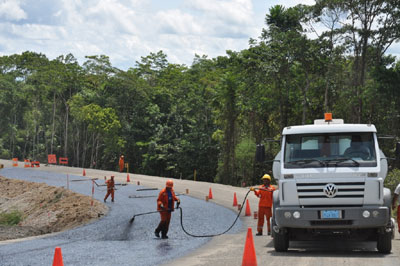Countries of the Region Must Annually Invest
US$ 170
Billion to Close the Infrastructure Gap

Photo: Amazonia Puno - Madre de Dios, Flickr
Infrastructure is a highly effective mechanism for reducing poverty and achieving economic development. However, investments in this area in Latin America and the Caribbean have fallen over the past years, which has widened the gap or distance between the infrastructure requirements and its effective provision.
According to the study The infrastructure gap in Latin America and the Caribbean, significant work is needed to achieve the required figures, given that investment observed in this area over the last known period (2007-2008) was only 2% of GDP.
The authors, Daniel Perrotti and Ricardo Sánchez, warn that the way in which these issues are dealt with by the countries in the region will be a key determinant of how the region is positioned in the twenty-first century, both with respect to the global economy, in the fulfillment of its development goals and in terms of the quality of life of its inhabitants.
According to the ECLAC study, Latin America and the Caribbean will have to invest around US$ 170 billion annually (around 5.2% of the region’s GDP) in order to meet the needs of companies and individuals between 2006 and 2020, compared to the US$100 billion invested today, assuming that the average annual economic growth will be 3.9% in the region over this period.
However, in order to attain the levels of per capita infrastructure stock of a group of South-East Asian countries, the annual figure would rise to 7.9% of the region’s GDP (almost US$ 260 billion).
The report explains that infrastructure refers to all engineering structures, equipment and physical facilities that are the basis for providing services to productive sectors and households.
The sectors analised in this work are mainly related to economic infrastructure (transport, energy and telecommunications) and part of the social infrastructure (drinking water and sewage systems).
The study reveals that the figures for investment are only a minimum effective threshold and they consider just a part of the total economic infrastructure. Furthermore, only spending in investment and maintenance has been considered; expenditures in rehabilitating and upgrading the existing stock have been excluded.
The document also discusses alternative funding to cover this deficit, which involves both the public and private sector. These forms of funding include generating partial risk guarantees provided by multilateral organizations –according to proposals made by the World Bank (2007)- and initiatives which are part of the wider concept known as “financing for development”, which is one of the priorities of ECLAC 2012-2013 biennial work programme.
The document concludes that investment in infrastructure is
necessary for development, but it is not enough on its own. The
impact of infrastructure on growth of a country will depend on
other factors, such as the extent of human capital development,
the availability of natural resources, and access to funding and
technology, among others.
More
HEADLINES
Fertility and Inequality in Latin America
| Investment observed in infrastructure over the last known period (2007-2008) was only 2% of GDP. | |
|
|
|
|
The way in which these issues are dealt with by the countries in the region will be a key determinant of how the region is positioned in the twenty-first century, both with respect to the global economy, in the fulfillment of its development goals and in terms of the quality of life of its inhabitants. |
|